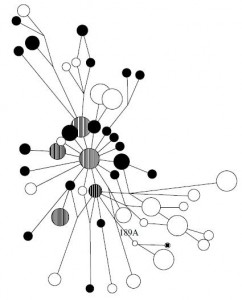A Romani Mystery in Eleventh-Century England March 9, 2012
Author: Beach Combing | in : Medieval , trackback***Dedicated to Stephen D***
Our knowledge of the ancient and medieval movements of peoples depends on extraordinarily inadequate contemporary sources and the deadly (and often unsupported) prejudices of historians and archaeologists. But now, with the use of DNA sampling and other techniques, including isotope analysis, science is coming to the rescue: giving us surprising insights into long dead periods and blowing away our assumptions like so many cobwebs.
Beach particularly likes a paper from Biology Letters (2005) 280-282 by Töfp and Rus Hoelzel that makes a mockery of certain British chronologies. The authors were surprised (to say the least) to find a Romani mitochondrial haplotype in a cemetery in Norwich in East Anglia, a cemetery that was in use from the tenth to eleventh centuries ‘ca. 930-1050’. This means that – drum roll – somehow Gypsy (‘Romani’) DNA got into the English blood stream prior to 1000 AD: which is pretty extraordinary given that the Romani are generally thought to have got to the United Kingdom c. 1600 AD!
Beach noted in his post of yesterday that he does not read Russian. And he should note at this point that he does not read DNA either. The graphic above is, for example, supposed to mean something and sentences like the following leave him feeling not only inadequate but also vaguely nauseous: ‘A fragment of 264 bp (including primers) of the mtDNA HVS-I was amplified using primers 16099 (50AACCGCTATGTATTTCGTAC30) and 16331 (50TTTGACTGTAATGTGCTATGTA30) (numbering according to Anderson et al. 1981).’
Quite.
But even a DNA dullard like Beachcombing knows that the Romani are special. As a sub-continental people who made it into the Mediterranean Basin and subsequently as far as Scotland and Scandinavia: the Romani brought an entirely alien strain of DNA deep into a region with its own distinctive genetics. The result is that Romani DNA is particularly easy to pick out: certainly, it easier than arguing about the DNA differences between ‘Celts’ and ‘Germans’ and similar such nonsense.
With this by way of apology how do the authors explain this embarrassing stray? Well, they kindly offer five explanations:
1) An independent mutation in the British population: ‘very unlikely’.
2) A Romani-style halotype which may be present but undetected in the European population: ‘the probability is very low’.
3) The halotype was common in Saxon times but has since been lost: the authors also think this is improbable.
4) A Viking serving in the Varangian Guard in the ninth or tenth century somehow fathered, with a Romani mother, a child who later came to Britain or who was born there.
5) ‘The independent arrival of Romani people in England, 500 years before the oldest known record’.
Beach has not the knowledge to pontificate on the arguments for (1-3): all he can note is that the authors do not seem to take them too seriously. If readers know better or if research has since changed things please let Beach know: drbeachcombing AT yahoo DOT com
The Varangian route seems to be rather tortuous. East Anglia had an iced sugar Norse sprinkling but was not part of the mad-dog cursed Viking heartlands: Orkney, Cork etc. Were there even Romani in the Byzantine empire in c. 950 say? Our best – though admittedly very uncertain sources – would say not.
The final possibility is surely the best one – if the authors can be trusted in their judgements over 1-3. It is attractive because it covers so many possibilities. It could involve a small group of Romani mercenaries being hired into an East Anglian fyrd: though how did they get there? Or it could, instead, be a Romani slave traded through Syria and up onto the Northern European trade routes: God help her!
Then a final thought. It would be interesting to know how exclusive this mitochrondrial haplotype was in India. If we are talking about a general Indian feature – the “gypsies” only in European terms – Indian contact with Anglo-Saxon England would be easier to explain than the specific movement of one nomadic tribal society, the Romani. Beach remembers earlier posts including the embassy to St Thomas.
In any case, fascinating stuff and thanks again to Stephen for taking the time to send this stoneless cherry in.
***
18 March 2012: Karen writes in: Phoenicians were traders for tin, and travelled to many countries. Perhaps they also traded in slaves. Celts were known to hire themselves out as mercenary warriors at times. Even to distant lands. (Galatia was a settlement of Celts, and although these were probably not from Britain, certainly it shows that mercenaries could and did go far afield for opportunity.) Warriors are known to take slaves as booty. There is no reason to think that Celtic people had no slaves from other countries. There were soldiers in England from many areas of the Roman world. Higher ranking officers sometimes had slaves, or brought wives. Royalty, especially, was known to have slaves, and often a taste for exotic ones. Also English royals did marry royals from Europe. In those days, DNA tests did not exist, so it would be impossible for a king or prince or lord to tell if a baby was really his, especially if he were Spanish, Portuguese or a swarthy Eastern European himself. The era of the gravesite is a time marked by wars and pestilences, with rough knights hardly more than terrorists of the peasants in Europe. In such confusing times, who knows who was brought to England or by whom? This Romani DNA, while found in a gravesite from 950 or 1000, could have been passed down for many many generations in England, and indeed may still be in some small population of very “white” English persons.’ thanks Karen!!



